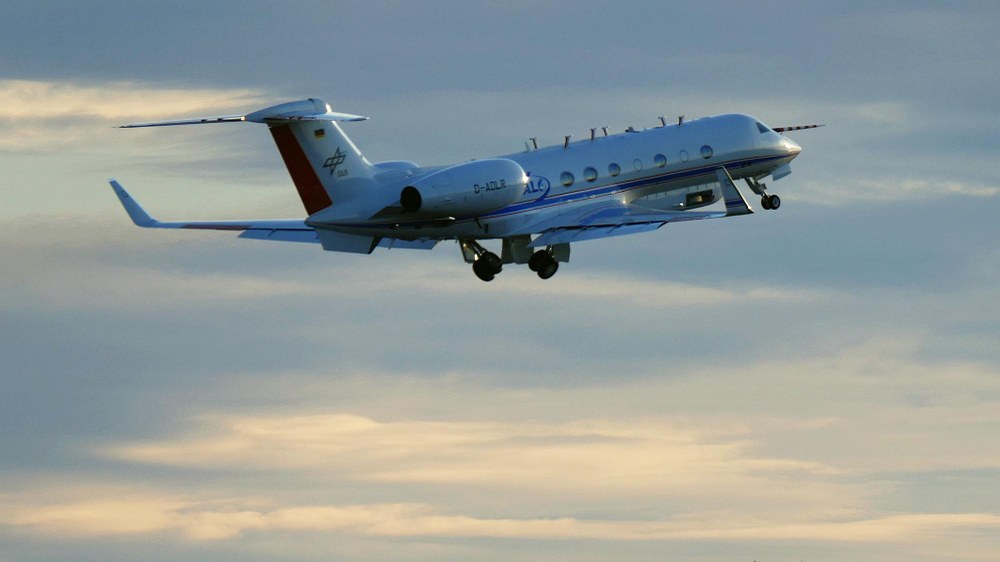HALO research aircraft – climate research high above the Arctic
In the icy environment high above the Arctic and working in close cooperation with other German research institutes, scientists from the German Aerospace Center (Deutsches Zentrum für Luft- und Raumfahrt; DLR) are going to investigate the complex processes involved in climate change and their impact on the polar atmosphere. The HALO (High Altitude and Long Range) research aircraft will conduct three measurement campaigns during the polar winter to analyse changes in the composition of the upper troposphere and lower stratosphere above the Arctic.
Unique atmospheric research with HALO
Based at Kiruna in north Sweden, the climate researchers will use HALO to conduct measurement flights throughout the Arctic winter, seeking to investigate the hitherto insufficiently understood aspects of cloud physics in polar regions and trace substance transport. For this purpose, the scientists will use one of the world's best-equipped research aircraft – the Gulfstream G550 HALO. "HALO is the ideal all-purpose tool to conduct climate research in the northern polar region," says Oliver Brieger, Head of Flight Operations at DLR. "It can be deployed flexibly, has a range of 8000 kilometres, plenty of space for scientific instruments, and can fly as high as 15 kilometres." This unique set of tools makes HALO one of the few research aircraft that can reach the North Pole. For the upcoming missions, the DLR Institute of Atmospheric Physics will equip the aircraft with a LIDAR (Light Detection And Ranging) system, a mass spectrometer and a nitrogen oxide detector. The team is currently completing preliminary test flights from the DLR base in Oberpfaffenhofen. Three research missions (POLSTRACC, GW-LCYCLE and SALSA) will then take place between December and March to investigate the composition of the atmosphere above the northern polar region.
Polar stratosphere during climate change
While an ozone hole regularly forms above Antarctica in the southern hemisphere's spring, ozone depletion in the northern hemisphere above the Arctic only reaches similar magnitudes during extremely cold winters. The recovery of the ozone layer that has taken place globally since the 1990s is primarily due to the strict regulation of climate-damaging chlorofluorocarbon (CFC) emissions. But ozone does not just protect Earth against dangerous solar radiation – it is also a greenhouse gas that strongly influences the climate, particularly in the transition zone between the troposphere and the stratosphere.
During the Polar Stratosphere in a Changing Climate (POLSTRACC) campaign, the scientists will focus on the chemical and dynamic processes taking place in the lower stratosphere. "Climate change alters the dynamics of the atmosphere and thus has an effect on the occurrence of ice clouds in the northern polar region and the chemical reactions that take place in them. We will use our instruments to analyse these cloud processes and how they impact the ozone balance in the currently changing polar region," explains Christiane Voigt from the DLR Institute of Atmospheric Physics. For instance, the increasing levels of greenhouse gases cause the temperatures close to the ground to rise. In contrast, the scientists expect to find that the stratosphere has become cooler.
"The effects of climate change are well known, but there has been insufficient research into the complex processes behind it and what role clouds play," Voigt continues: "And that is precisely what we are looking to address by conducting the HALO measurement flights." The POLSTRACC mission will take place in conjunction with the Seasonality of Air mass transport and origin in the Lowermost Stratosphere (SALSA) mission using the HALO aircraft. The aim of SALSA is to determine the influence of certain dynamic and meteorological systems on the distribution and transport of greenhouse substances in the tropopause region, the boundary layer between the troposphere and the overlying stratosphere. The joint project is being led by the Karlsruhe Institute of Technology (Karlsruher Institut für Technologie; KIT) and the Goethe University Frankfurt in a consortium including DLR, the National Metrology Institute of Germany (PTB), the Jülich Research Centre (Forschungszentrum Jülich; FZJ) and a number of other German universities.
Propagation of gravity waves
The Gravity Wave Life Cycle Experiment (GW-LCYCLE) is designed to investigate the propagation of gravity waves. This phenomenon can occur in the lower atmosphere (troposphere) and spread to the upper atmosphere (stratosphere and mesosphere). There, they cause fluctuations in wind strength and temperature, influencing the energy balance and, in the long term, the climate. "Kiruna, in northern Sweden, is a particularly good place to observe these phenomena, as the Scandinavian mountains and the weather systems in the northern polar region can trigger strong gravity wave events," explains Markus Rapp, Director at the DLR Institute of Atmospheric Physics. The scientists will also use a second aircraft from the DLR research fleet to conduct their measurements – the Falcon. For some missions, Falcon will fly in formation with HALO. While HALO will direct its instruments towards the upper atmosphere, Falcon will investigate the lower layers. "In the past, it was only possible to measure gravity waves either in the lower or in the upper atmosphere. Now we can measure throughout the entire atmosphere at the same time. This is an important step in climate research that will help us to understand the flow patterns and to create forecasts," explains Rapp. DLR will be the scientific lead for the project, which is funded by the German federal Ministry of Education and Research (Bundesministerium für Bildung und Forschung; BMBF).
About HALO
The HALO research aircraft is a collective initiative by German environment and climate research bodies. HALO is funded by contributions from the German Federal Ministry of Education and Research (Bundesministerium für Bildung und Forschung; BMBF), the German Research Foundation (Deutsche Forschungsgemeinschaft; DFG), the Helmholtz Association, the Max Planck Society, the Leibniz Association, the Free State of Bavaria, the Karlsruhe Institute of Technology (KIT), the German Research Centre for Geosciences (Deutsches GeoForschungsZentrum; GFZ), the Jülich Research Centre (Forschungszentrum Jülich) and the German Aerospace Center (Deutsches Zentrum für Luft- und Raumfahrt; DLR).



